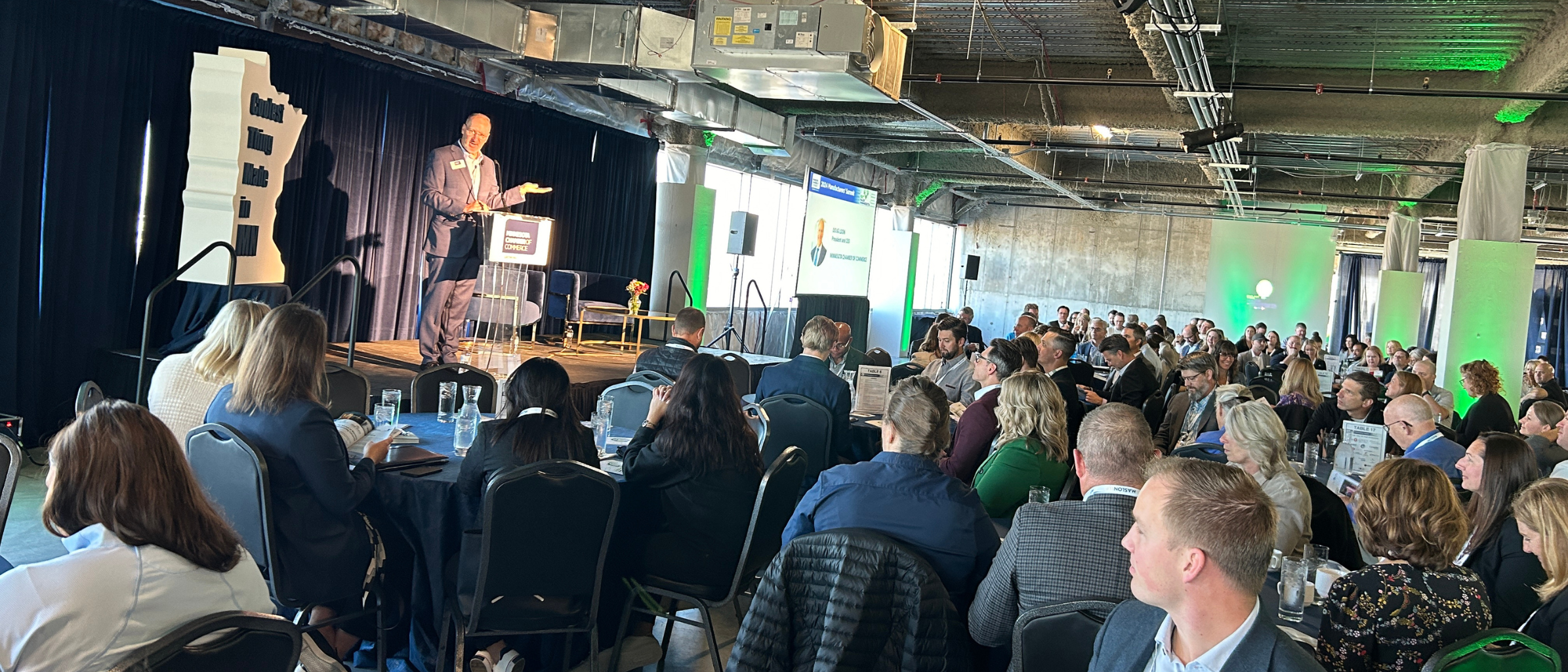On October 8, 2024, the Minnesota Chamber of Commerce hosted its annual Manufacturers’ Summit, bringing together industry leaders, business owners, and policymakers to explore the future of manufacturing in Minnesota.
Held in the aptly industrial Offices at Mall of America, this year’s event also featured the inaugural “Coolest Thing Made in Minnesota” award ceremony, celebrating the innovation and creativity behind locally produced products. The summit served as a platform for discussing key issues facing manufacturers of all shapes and sizes, from workforce development and automation to tax policy and reshoring efforts.
Local manufacturing leaders from ME Elecmetal, Tube Bending Specialists, and SkyWater Technology also hosted a spirited discussion about growth, attracting talent, accelerating investment, and competing in a global economy.
Below are six takeaways from the summit that highlight the challenges and opportunities ahead for manufacturers in Minnesota and across the nation.
1. Small businesses must stay resilient in the face of tax & regulatory challenges
An influx of state-level mandates is reshaping how businesses operate, presenting challenges for small and mid-sized manufacturers. Unlike larger corporations that can absorb compliance costs more easily, smaller businesses must often juggle these financial and operational burdens with limited resources.
“Sometimes people think that as a business owner, you’re a millionaire or something, which is not always the case. And I think sometimes our government thinks that as well,” explained Nichole Mundis, owner of the metal bending and fabricating company, Tube Bending Specialists. “The amount of money we’re paying in taxes could probably employ two or three more people. At the end of the day, someone has to pay for those tax hikes.”
She continues: “It’s personal for me because I have employees and family members work for us, too—they’re all family. It gets tough every time the government puts in new regulations. Since COVID, probably 75% of my job has been monitoring what’s happening with the government, figuring out how it will affect us, and deciding what price increases we might need to make.”
Navigating these regulations successfully requires adaptability and strategic planning. Businesses that stay agile, invest in understanding the regulatory landscape, and seek out support—whether through chambers of commerce or industry networks—can stay ahead of the curve. In states like Minnesota, where regulations can be stricter than in neighboring states, businesses are forced to weigh the community benefits of staying local versus the operational advantages of relocating.
2. R&D tax credits are vital to innovation & global competitiveness
For industries that rely heavily on research and development, tax credits are more than just a financial perk—they are a lifeline for growth and innovation. In capital-intensive sectors like mining and semiconductors, R&D tax credits provide financial leverage to fund new technologies and maintain global competitiveness. Without these credits, companies are forced to make tough decisions about where to allocate resources, and in many cases, this means weighing whether to keep operations in the U.S. or move them overseas to more tax-friendly environments.
“By 2033, we’re going to double our business, so we need to make decisions today on where we can invest that capital for the capacity growth and demand we see around the world,” explained Ted Angelo, president of the global mineral processor, ME Elecmetal. “If we get the right capital investment, we can compete against foreign companies. [That investment] helps us reduce energy, labor, and other inputs. But losing those tax credits takes away the benefit from those investments.”
This illustrates the critical role that state and federal policies play in shaping business decisions. States that offer more generous R&D tax incentives can be more attractive to companies looking to expand or hire, making these credits a key factor in job creation and regional economic growth.
“Believe it or not, we get 2.8 times more tax credit in Arizona than we do in Minnesota, even though the size of the team and the spend is roughly equal. So, it’s a big deal for us,” Angelo said.
3. Building a skilled workforce means investing in education & training
One of the most pressing challenges in manufacturing today is the shortage of skilled labor. To overcome this, businesses must look beyond immediate hiring needs and adopt a long-term workforce development strategy. This involves creating a talent pipeline that introduces tomorrow’s workforce to the career possibilities in manufacturing and the trades.
“I think you have to start early and get kids interested in STEM positions,” said John Sakamoto, president and COO of semiconductor manufacturer, SkyWater Technology. “We reach out to kids and teachers in middle schools and high schools, bring them into the facility, and explain what we do and what skills they need. We also have a great internship program with the University of Minnesota.”
But workforce development doesn’t stop at education and recruitment. Retaining skilled labor requires continuous investment in training and clear career pathways. Businesses that offer structured training programs and opportunities for advancement are more likely to keep their employees and create a culture where workers see a long-term future.
“One of the things we did was introduce training and orientation coordinators,” Angelo explained. “When someone starts at our company, we conduct a skills assessment to understand their work style. Then, our training and orientation coordinators work with them over several months to help them acclimate to the foundry environment. Basically, showing them what success looks like, what to do and what not to do. This approach has significantly improved our workforce’s productivity and retention. In fact, our turnover and overtime rates are now a fraction of what they were two or three years ago.”
4. Automation & AI should be used to empower employees, not replace them
Like almost every other industry, automation and AI are rapidly transforming manufacturing in Minnesota. But despite growing fears, these tools don’t have the ability to take anyone’s job. Rather, they are invaluable allies that empower workers and help them gain efficiency.
“We’re using automation for very physically demanding or tedious tasks,” Angelo said. “We step back and try to automate things that make it a safer place to work for employees.”
Sakamoto agrees: “A lot of the manual work in manufacturing is identifying defects through visual inspection. We simplified that by training our AI model to identify known defects. We can get a higher yield and do that work much quicker by using AI. For all of us, it’s important we adopt this technology as quickly as possible because, in a global environment, companies are adopting it very rapidly.”
The panel’s message was clear: Automation and AI aren’t threats. They’re tools that can unlock greater potential for workers and help businesses boost efficiency, safety, and innovation.
5. Reshoring is key to strengthening American manufacturing
The disruptions caused by COVID-19 exposed the vulnerabilities of global supply chains, prompting many manufacturers to reconsider where they invest capital. With rising concerns over labor costs, tax incentives, and energy prices, reshoring has become a viable strategy for reducing risk and strengthening economic resilience.
“America works best when we manufacture things,” Angelo concluded. “As elected officials, consider how you can bring production back to the U.S. How can we get the reshoring process going again? By bringing manufacturing back, you won’t have to worry about tariffs or long supply chains. As COVID showed us, the vulnerabilities of long supply chains can be catastrophic. We’re still recovering from those impacts, and reshoring is key to building a more resilient manufacturing economy.”
Initiatives like the Reshoring Initiative help businesses evaluate the true costs of offshoring and highlight the benefits of investing locally. Reshoring also helps the U.S. reclaim its leadership in advanced sectors where innovation and workforce development are crucial to maintaining global competitiveness.
“Semiconductors have strategic importance across a broad range of industries—whether it’s building industrial equipment, supporting the automotive sector, or advancing computing technologies,” Sakamoto said. “It’s crucial that we not only remain a leader in developing semiconductor technology, which we are today, but also in manufacturing it. This impacts every industry. The semiconductor shortages in places like China and Taiwan have shown how essential it is for us to maintain leadership in this space.”
6. Engaging lawmakers is essential for a pro-manufacturing future
One of the most impactful ways manufacturers can influence policy is by actively engaging with lawmakers. Whether during election seasons or throughout the year, building relationships with elected officials is key to ensuring they understand the unique challenges manufacturers face. Open dialogue with policymakers allows businesses to share their stories, provide firsthand insights into their operations, and highlight how regulations, taxes, and workforce issues affect their ability to grow and innovate.
“It’s important for us to go to our representatives and talk to them, not as a Democrat or a Republican, but as a human being. Tell them your story—that’s what will help them understand,” Mundis said. “I once went to speak with a legislator, and as soon as we sat down, she crossed her arms and said, ‘So, what are you here to lecture me on today?’ I didn’t know how to respond at first, so I said, ‘Let me just tell you about my business and my family.’ By the time we finished, we were best friends. We didn’t talk about politics; we talked about who we were as people.”
Inviting lawmakers to tour facilities and witness manufacturing processes in action can be particularly powerful. These visits give officials a clear picture of the real-world impacts of legislation and help bridge the gap between government policies and industry needs.
“When they see the work being done, when they see the faces of the people behind the machines, and hear their stories about what they do, it really brings everything into perspective,” Angelo explained. “They better understand the pay, benefits, and other things that contribute to the local economic impact.”
Sakamoto believes that engaging with lawmakers is not just a nice-to-have—it’s a strategic necessity. By shaping policies that support growth, manufacturers can create a more favorable environment for their industry, ensuring a stronger, more competitive future.
“We’re a small company, but we have a full-time person dedicated to government relations. That role is critical for outreach and educating officials about what we do, as well as understanding funding opportunities from the government,” he explained. “Yes, it’s an expensive resource, but for us, it’s worth the investment. I encourage everyone to consider making a similar investment because the return is significant.”



